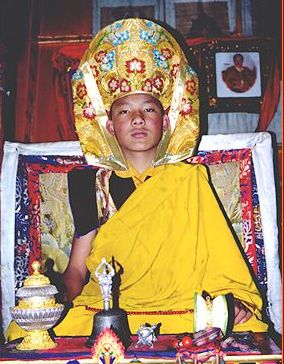Meaning 'Kalachakra', History and Initiation by His Holiness The Dalai Lama !
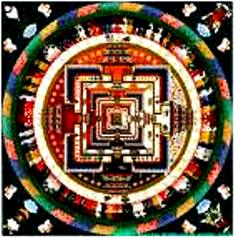
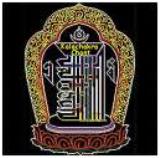
Kalachakra
An Introduction to the Kalachakra..
General Presentation of the Dharma
The Buddha's Dharma,is mainly of two sects, the 'Hinayana' and the 'Mahayana'. The Hinayana itself can divided into the vehicle of the 'shravakas' and the vehicle of the 'pratyeka-buddhas'. The shravakas and pratyekabuddhas can be identified according to the relative difference of their faculties and the results they obtain, but the mother doctrine remains the same. People with a propensity to follow these two Hinayana vehicles take them up for the sake of merely their own emancipation, because they turn their backs on bearing the burden of the aims of others. Since the main cause of bondage in 'samsara' is grasping at a self, the main cause of obtaining the freedom of liberation is the wisdom that realizes the meaning 'selflessness'. Thus, shravakas and pratyekabuddhas, like 'bodhisattvas', realize selflessness. Their meditative path is accompanied by the other paths of moral conduct, concentration and so forth, and thus elliminates all their passions, greed, hatred, and ignorance.
Even though 'Hinayanists' do not engage in their path intending to obtain Buddhahood, their path is in fact a mean for finally helping people to achieve the state of buddhahood.The Buddha appears in the world so that sentient beings may obtain the doctrine of Good Karma that he himself practised.
Although followers of the Hinayana, like followers of the Mahayana, realize that phenomena are devoid of own-being, it is not the case that there is no difference at all between the Hinayana and the Mahayana. The doctrines of the Mahayana do not merely illuminate the selflessness of phenomena, they teach the bodhisattva stages, the perfections, the prayer to achieve perfect enlightenment for the sake of all sentient beings, great compassion, and so forth. They also teach the dedication of merits to enlightenment, the two accumulations of merit and gnosis, and the inconceivable reality that is purified of all stains.
Thus, the Mahayana and Hinayana are not distinguished due to differences in their philosophical viewpoints, but they are differentiated according to their respective practice and non-practice of the entire range of skillful means. This is the assertion of Arya Nagarjuna and his disciple Aryadeva: A mother is the common cause of all her sons, and their fathers are the causes for distinguishing their races. Just so the mother, the perfection of wisdom, is the common cause of the sons, all four kinds of 'aryas': shravaka aryas, pratyekabuddha aryas, bodhisattava aryas, and buddha aryas.
The cause for differentiating them into the particular Hinayana and Mahayana lineages is whether or not they have the methods of generating 'bodhichitta' and so forth. The general Mahayana, like the Hinayana, can be subdivided into two vehicles: the 'Paramitayana' and the 'Mantrayana'. The common aim of the Mahayana is to train oneself in the six perfections by practising them out of a desire to obtain unexcelled enlightenment for the sake of all sentient beings. It is clear that one proceeds in the Mantrayana by this same path, because it is taught in the tantras.
The terms "Cause vehicle", "Paramitayana", and so forth are synonyms, and "Mantrayana", "Vajrayana", "Effect vehicle", and "Method vehicle" are synonyms as well. There is a difference between the cause vehicle and the effect vehicle: the cause vehicle is the Mahayana vehicle in which there is no meditation on oneself having a like aspect with any of the effects-the four complete purities-during the period of the path of training. The Mahayana vehicle in which there is meditation on oneself as having a like aspect with the four complete purities during the period of the path of training is called "The Effect vehicle" or "The Mantrayana". This is what the master 'Tsongkhapa' said in the Ngag Rim Chenmo: "With regard to vehicle, since it is the vehicle of, i.e., conveys, the effect that is desired here and the cause that desires this, it is called 'vehicle'. The effect is the four complete purities of abode, body, property, and activities, a buddha's palace, body, wealth, and deeds. One meditates from the present on oneself as having a divine mansion, a divine entourage, divine ritual implements, and the divine deeds of purifying the cosmos and its inhabitants, just like a Buddha, Thus, it is the Effect Vehicle because one progresses through meditating in accordance with the vehicle of the effect."
With regard to the disciples of the Mantrayana, there are four types: inferior, middling, superior, and most excellent. The four classes of tantra were taught with these four types of disciples in mind. Since the disciples enter the Mantrayana through the four classes of tantra, the four classes are likened to "four doors." Should you wonder what the four are, they are Ritual Tantra, Conduct Tantra, Yoga Tantra, and Unexcelled Yoga Tantra. The Kalachakra, which will be described below, belongs to the Unexcelled Yoga Tantra class.
An Account of the Kalachakra, or Wheel of Time..
The entire meaning of the subject matter of the 'Kalachakra tantra' is included within the three Kalachakras, or 'Wheels of Time': The 'Outer Wheel of Time', the 'Inner Wheel of Time', and the 'Other Wheel of Time'. The Outer Wheel of Time is the external world of the environment, and it is also called "The procession of the external solar and lunar days." The Inner Wheel of Time is the human body, that is an inner 'Jambudvipa', or earth-surface. Likewise, the inner channels, elements, and movements of the winds are set forth as the Inner Wheels of Time. The Other Wheel of Time is the initiations and paths of Shri Kalachakra, together with their results. It is "other" than the preceding two Wheels of Time.
The guru trains the disciple's psycho-physical continuum with the initiations, and the disciple meditates on the path that consists of the generation process and the completion process. In this way the yogi actualizes the result.. the buddha body, that is the divine image of emptiness. This is the Other Wheel of Time.
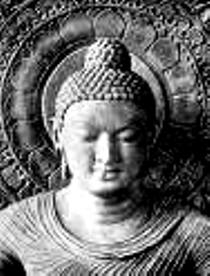
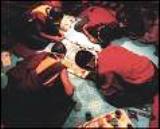
The Buddha's teaching of the Kalachakra is described in the Paramadibuddha, the Kalachakra, Basic Tantra:
"As the teacher demonstrated the Dharma on Vulture Heap according to the Perfection of Wisdom system, he also taught the mantra system at 'Shri Dhanyakataka'. What teacher taught what tantra, when and where was he dwelling? What was the place, who was the worldly entourage, and what was the purpose?
"He taught the unexcelled Mahayana, the system of the Perfection of Wisdom, to the bodhisattvas on Mount Vulture Heap. Then at the same time the Tathagata dwelt together with bodhisattvas and others in the great stupa, in the mandala of the sphere of phenomena. He dwelt in the house of universal vajra, in space, immaterial and very lucid, unpartitioned and radiant. He taught the tantra in the beautiful sphere of phenomena, for the merit and gnosis of human beings."
The Basic Tantra also says: "Then Vajrapani's emanation, King Suchandra from famous Shambhala, miraculously entered into the splended sphere of phenomena. First he circumambulated to the right, then he worshipped the teacher's lotus feet with flowers made of jewels. Placing his hands together, Suchandra sat before the perfect Buddha. Suchandra requested the Buddha for the tantra, re-acted it, and taught it too."
The Kalachakra was taught by our teacher, the Buddha Shakyamuni. He showed the way of actualizing highest perfect enlightenment underneath the bodhi tree at Bodh Gaya in India, at early dawn on the full moon of April/May. For one year he taught the general Paramitayana. In particular, at Mount Vulture Heap he turned the Dharma Wheel of the Perfection of Wisdom, the chief, ultimate Dharma Wheel of the Paramita system of the Mahayana.
On the full moon of March/April, the twelfth month counted from the time he obtained buddhahood, the Buddha was teaching the Paramitayana at Mount Vulture Heap. At the same time he manifested another form inside the great stupa of Shri Dhanyakataka, which is near Shri Parvata in south India where he taught the Mantrayana.
The great stupa was more than six leagues from top to bottom, and inside it the Buddha emitted two mandalas: below the mandala of Dharmadhatu Vagishvara, above the great mandala of the splendid asterisms. The Buddha was in the centre on the Vajra lion throne in the great Mandala of the Sphere of Vajra, the abode of great bliss. He was absorbed in the 'Kalachakra samadhi', and stood in the form of the Lord of the mandala.
The excellent entourage within the mandala consisted of a host of Buddhas, bodhisattvas, furies, gods, nagas, and goddesses. Outside the mandala the requestor was the emanated body of Vajrapani, King Suchandra of Shambhala. He had miraculously come to Shri Dhanyakataka from Shambhala, and he requested the Kalachakra for the entourage of listeners: the ninety-six emanated satraps of the ninety-six great lands within Shambhala, together with a limitless host of fortunate bodhisattvas, gods, demons, and others.
The Buddha gave the 'Sangha', the excellent Dharma-the worldly and transcendental initiations-and prophesied that they would obtain buddhahood, then he taught them the Paramadibuddha, the twelve thousand verse 'Kalachakra Basic Tantra' which was collected by King Suchandra in a volume before he miraculously went back to Shambhala.
In Shambhala, Suchandra composed a sixty thousand line commentary of the Basic Tantra. He also erected a 'Kalachakra mandala' made of precious substances. After he had appointed his son Sureshvara as King and teacher of the tantra, he passed away.
Many great Kings became the dynasty of Shambhala: Kalki Yashas, Kalki Pundarika, and others. Their firm faith made the Kalachakra Dharma shine like the sun and the moon.
The Kalachakra continued to be transmitted through the succession of kalkis ("chieftains") of Shambhala, and eventually it was reintroduced into India.
There are two main stories of how this came about, the story told by the 'Ra' tradition and the story of the 'Dro' tradition. (The Ra tradition and the Dro tradition will be discussed below).
According to the Ra tradition...the Kalachakra and related commentaries famed as the Bodhisattvas Corpus appeared in India during the simultaneous reigns of three kings. Taking Bodh Gaya as the center, the three kings were: Dehopala, the Master of Elephants, in the East; Jauganga, the Master of Men, in the South; and Kanauj, the Master of Horses, in the West. At that time the great pandit Cilu, who mastered all aspects of the Buddhadharma, was born in Orissa, one of the five countries of eastern India. Cilu studied all the Buddhist texts at the Ratnagiri Vihara, Vikramashila, and Nalanda. In particular, he studied at the Ratnagiri Vihara that was undamaged by the Turks.
Cilu realized that, in general, in order to achieve buddhahood in a single lifetime he would need the Mantrayana, and in particular, that he would need the clarifications of these doctrines contained in the Bodhisattva commentaries. Knowing that these teachings were extant in Shambhala, and depending on the instruction of his deity, he joined up with traders who sought jewels in the ocean. Having agreed with the traders, who were setting out across the sea, to meet up after six months, they went separate ways.
Cilu proceeded in stages and finally, upon climbing a mountain, he met a man. The man asked him, "Where are you going?" Cilu replied, "I am going to Shambhala in search of the Bodhisattva Corpus." The man said, "It is extremely difficult to go there, but if you can understand it, you could listen to it even here." Cilu realized that the man was an emanation of Manjushri. He prostrated, offered a mandala, and requested instruction. The man conferred all the initiations, tantra commentaries, and oral instructions on Cilu. He grasped Cilu, placed a flower on his head, and blessed him, saying, "Realize the entire Bodhisattva Corpus." Thus, like water poured from one vessel into another, Cilu realized the entire Bodhisattva Corpus. He went back the way he had come and, meeting with the traders, he returned to Eastern India.
According to the Dro tradition... the Kalachakra was reintroduced into India by the master 'Kalachakrapada'. A couple who practised the 'Yoga of Yamantaka' performed the ritual for the birth of a son as it is taught in the Yamantaka Tantra, and had a son. When he grew up he learned that in the north the bodhisattvas themselves taught the Dharma, so he went to listen to them. With his psychic power the Kalki of Shambhala knew of the youth's pure motivation and enthusiasm for the profound Dharma. He knew that if the youth attempted to come to Shambhala it would endanger his life because of the waterless wasteland that takes four months to cross. Thus, the Kalki used an emanation body to meet the youth at the edge of the desert.
The Kalki asked the youth, "Where are you going, and why?" when the youth told him his intentions the Kalki said, "That road is very difficult. But if you can understand these things, couldn't you listen to them even here?" The youth realized that this was an emanation of the Kalki and asked him for instruction. Right there the Kalki initiated the youth, and for four months he taught him all the highest tantras especially the three Bodhisattva Corpus commentaries. Like a vase filled to the brim, the youth realized and memorized all the tantras. When he returned to India he became renowned as an emanation of 'Manjushri', and his name was "Kalachakrapada"
The Ra and Dro traditions say that the Kalachakra was introduced into India by Cilu and Kalachakrapada. The Kalachakra continued to be studied and practised in India, and it was eventually introduced into Tibet.
The Dro tradition started from the visit of the 'Kashmiri Pandit Somanatha' to Tibet. Somanatha first arrived in Tibet at Kharag and stayed among the Ryo clan. For a fee of one hundred measures of gold Somanatha translated half of the great Kalachakra commentary, the Vimalaprabha, into Tibetan, but in the meantime he became displeased and stopped his work. He took the gold and his draft translation and went to Phan Yul drub. There Chung Wa of the Zhang clan took Somanatha as his guru, and Shayrabdrak of the Dro clan acted as translator. Somanatha and Shayrabdrak translated the entire Vimalaprabha.
The Ra tradition started with Chorab of the Ra clan, the nephew of the famous translator Ra Dorjedrak who was born in Nyen Ma Mang Yul. Ra Chorab memorized and understood all the doctrines of the Ra clan. Then he wished to learn the Kalachakra, so he went to the centre of Nepal where he continuously served the Pandit Samantashri for five years, ten months, and five days. Samantashri explained all the Kalachakra texts and gave Chorab the initiations and oral instructions. Then Chorab invited Samantashri to Tibet where they carefully translated the Kalachakra tantra and its commentary, together with the auxiliary texts.
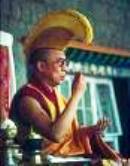
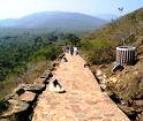
KALACHAKRA PRACTICE...
Practice of the Kalachakra tantra, like all Buddhist tantric systems, is based on first receiving the proper initiations. For the initiations to be properly given and received it is necessary that both the guru and the disciple have certain qualifications. The qualifications of the Mantrayana guru are described by Losang Chökyi Gyaltsen as follows:"He should have control over his body, speech, and mind. He should be very intelligent, patient, and undeceitful. He should know the mantras and tantras, understand reality, and be competent in composing and explaining texts". We are very fortunate that such gurus can be found even now.
The disciple should have experience of the three principal aspects of the Mahayana path: renunciation of samsara, bodhichitta, and understanding of emptiness. If the disciple has not actually experienced these, he or she should at least have intellectual familiarity with them and admiration for them.
The most important of the three aspects is bodhichitta, the primary motivation for taking the initiations.
'Lord Maitreya' defined 'bodhichitta' in his 'Abhisamayalankara': "Bodhichitta is the desire for true, perfect enlightenment for the sake of others". When applied to the specific circumstance of taking the Kalachakra initiations, the disciple should generate bodhichitta in the following manner: "For the sake of all sentient beings I must achieve the state of Shri Kalachakra. Then I will be able to establish all other sentient beings in the state of Shri Kalachakra as well". With this motivation one should take initiation.
The general aim of tantric initiations is that through the initiations the guru ripens the disciple's psycho-physical continuum. Here "ripening" means empowering the disciple to practise the yoga of the generation process and the completion process. In particular, the Kalachakra initiations empower the disciple to practise the yoga of the Kalachakra tantra, and, ultimately, to achieve the state of 'Shri Kalachakra'.
There are eleven Kalachakra initiations: seven initiations of "entering like a child", three "exalted" initiations, and one "most exalted" initiation. Disciples who are temporarily intent on just the worldly siddhis (magical or mystical accomplishments) are given only the seven lower initiations. Those who are mainly interested in the transcendental siddhi of buddhahood are given all eleven initiations. The first of the seven initiations of entering like a child is the water initiation. This is analagous to a mother washing her child immediately after its birth. The second initiation is the crown initiation that is analogous. to the binding of a child's hairlocks. The third, ribbon initiation is analogous to piercing a child's ears and arraying it with ornaments. The fourth initiation, the vajra and bell initiation, is analagous to a child laughing and talking. The fifth initiation is the discipline initiation, it is analagous to the child's enjoyment of the five desirable sense-objects. Sixth is the name initiation, analagous to the naming of the child. The seventh, and final, initiation of entering like a child is the mantra authorization initiation. This initiation empowers the disciple to eliminate obstacles and to achieve the magic powers of pacification, gaining prosperity, subjugation, and destruction.
The three exalted initiations are as follows: the vase initiation is the gnosis of bliss and emptiness that arises from the disciple touching the consort's breasts. The secret initiation is the gnosis of bliss and emptiness that arises from the disciple savouring the bodhichitta, The wisdom-gnosis initiation is the experience of connate joy that arises from the disciple and consort themselves engaging in union.
The most exalted initiation is also called "the fourth initiation" or "the word initiation" The previous great wisdom-gnosis initiation empowers the disciple to achieve the eleventh bodhisattva stage. Then the guru symbolically indicates the Gnosis Body that is the integration of supreme unchanging great bliss and emptiness possessing the best of all aspects. Saying, "This is it", the guru bestows the fourth initiation on the disciple. This initiation empowers the disciple to obtain perfect buddhahood in the form of Shri Kalachakra.
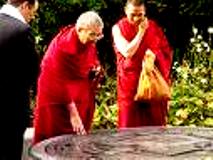
Kalachakra Initiations by the Fourteenth Dalai Lama
1. Norbu Lingka, Lhasa, Tibet, in May 1954
2. Norbu Lingka, Lhasa, Tibet, in April 1956
3. Dharamsala, India, in March 1970
4. Bylakuppe, South India, in May 1971
5. Bodh Gaya, India, in December 1974
6. Leh, Ladakh, India, in September 1976
7. Madison, USA, in July 1981
8. Dirang, Arunachal Pradesh, India, in April 1983
9. Lahaul & Spiti, India, in August 1983
10. Rikon, Switzerland, in July 1985
11. Bodh Gaya, India, in December 1985
12. Zanskar, Ladakh, India, in July 1988
13. Los Angeles, USA, in July 1989
14. Sarnath, India, in December 1990
15. New York, USA, in October 1991
16. Kalpa, HP, India, in August 1992
17. Gangtok, Sikkim, India, in April 1993
18. Jispa, HP, India, in August 1994
19. Barcelona, Spain, in December 1994
20. Mundgod, South India, in January 1995
21. Ulanbaator, Mongolia, in August 1995
22. Tabo, HP, India, in June 1996
23. Sydney, Australia, in September 1996
24. Salugara, West Bengal, India, in December 1996.
25. August 1999 Bloomington, Indiana, USA
26. August 2000 Kyi - Spiti, Himachal Pradesh, India
27. October 2002 Graz, Austria
28. January 2003 Bodh Gaya, Bihar, India
29. April 2004 Toronto, Canada
30. January 2006 Amarvati, Andhra Pradesh, India
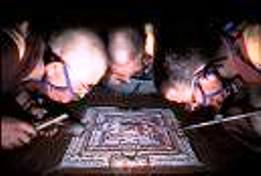
Kalachakra Mandala..
The word 'Kalachakra' means cycle of Time. The Kalachakra Tantra is a profound Buddhist system of teaching and practice which encompasses three aspects: Outer Kalachakra the external environment, the universe and its cycles of arising and disintegrating, and our world system and its cycles of sun, living in the universe, and the cycle of death and birth and internal flows of breath and energy; and Alternative Kalachakra – the practice of purification undertaken by an individual so that ordinary death, birth, and manifestation on both an individual and universal level, which are usually uncontrollably subjects to the passage of time, become purified into the fully Enlightened state of complete Buddhahood.
The 'Kalachakra Tantra' has particular relevance for our world system. The Tantra was taught by the Buddha in India two and half thousand years ago at the request of the King of Shambala, a place variously viewed as is having been an actual historical kingdom which existed beyond the Himalaya, or as a pure land existing on another planet not generally accessible but none-the-less strongly connected to our world. Predictions concerning Shambala have particular relevance to world events of today, being especially concerned with peace on this planet, and can also be compared with the predictive literature of other religions.
All Buddhist teaching are based on the Four Nobel Truths: the recognition that every sentient being experiences suffering; the understanding of the causes of this suffering; the recognition that if the causes are removed there will be an end to the suffering; and the practical methods by which to achieve Liberation from suffering, or full Enlightenment or Buddhahood. Within the Buddhist Tantras, the practice of Highest Yoga Tantra leads to perfect Buddhahood; the Kalachakra Tantra is a Highest Yoga Tantra, and such can be said to epitomize the apex of Buddhist Teachings. Only in Tibet were the Highest Yoga Tantras preserved and practiced as a living tradition after the decline of Buddhism in its native land of India.
Then 'Mandala', as represented here in particles of coloured sand, is the residence of the Kalachakra deity and the retinue of deities surrounding him, all of which represent the components of a single individual person in purified form-a fully enlightened being.
Although depicted here on a flat surface, the mandala is actually three dimensional, being a five storied divine mansion, at the center of which stand the Kalachakra deity, the manifest state of Enlightenment.
The sand mandala can be thought of as a plan of Kalachakra’s residence or pure environment. It represents a large building or palace, standing on a raised foundation, with four walls with a door in the centre of each; there is a roof over the whole building. The five stories of the palace represent the five levels of body, speech, mind, pristine consciousness, and great bliss. The colors of the four directions correspond with the colors of the four faces of Kalachakra; black in front, red to the right, white to his left and yellow at the back. The palace is surrounded bye various articles of offerings, and is resting on yellow, white, red and grey-blue discs which represent the four elements of earth, water, fire and wind. There are eight great cemeteries represented as wheels between the fire and wind perimeters; the other two wheels depict cemeteries above and below. There is a setting sun and a rising moon on the earth perimeter. The whole is surrounded by a protective fence of Vajras, and outside it is blazing light.
One can imagine entering the mandala through one of the outer doors at the first level, which of the body mandala, walking in through the outer walls, which are transparent and in five layers and colored, from outside to inside, yellow, white, red, black and green. You walk further in and climb up the each steps to the second level, the speech of Mandala, also surrounded by five transparent colored walls; up another set of steps to the third level, the mind mandala, surrounded by three transparent colored walls. You can see inside the mind mandala a square platform, the fourth level, the pristine consciousness mandala. On this platform is another platform, the fifth level, the great bliss mandala where the main Kalachakra deity stands on eight petal lotus.
A representation of this mandala is used by a practitioner of the Kalachakra Tantra for the purpose of visualizing in meditation. The every aspect of the Mandala has meaning, nothing is superfluous or arbitrary. As part of his or her training, a practitioner develops the power of meditative concentration to be able to visualize not only every details of the mandala, but also of the deities present within it.
Just to glimpse this sand mandala, however is thought establish a positive connection with this profound Buddhist Tantra, and to sow positive seeds upon the mind stream of the observer which will ripen beneficially in the future as the events of our world system manifest as predicted in the 'Kalachakra Teachings'.
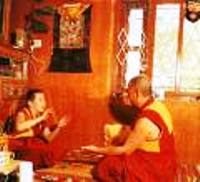
The Geshe Degree in Buddha Dharma of Mahayana & Hinayana..
Origin of the Geshe Degree for Kalachakra Doctrine
The first Tibetan Buddhist tradition to award a degree at the conclusion of the course of studies were the 'Sakyas' and like the 'geshe degree', it was granted on the basis of proficiency in dialectical debate. It was called 'Ka-shi' - four subjects, or 'Ka-chu'- ten subjects.
The Geshe Degree
A monk's curriculum is divided into six principal subjects organized into fifteen classes. These subjects were;
Collected Topics (bsdus-gra) which were preliminary to the syllabus proper.
Perfection of Wisdom (Prajraparamita, Par-phyin) Middle View (Madhyamika, dbuma) Valid Cognition (Pramana, tshadma) Discipline (Vinaya, 'Dul-ba) Knowledge (Abhidharma, mDzod)
Colleges such as 'Gomang' in Drepung, spent as long as eight years on Collected Topics alone. 'Tulkus' (recog-nised reincarnate lamas) were allowed to take their exams as soon as they had completed the cur-riculum and most returned to teach in their own monasteries in other parts of Tibet.
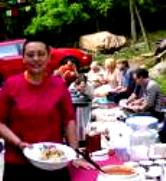
The College Feast
In the eleventh month, at great personal expense, the candidate offered a meal to the rest of his college to mark what was to be the most momentous event of his academic career. Immediately prior to the meal, led by the head of his hostel, he circled the assembly of monks, holding a stick of incense and a banner inscribed with verses. Originally these verses were composed by the monk himself to demonstrate his erudition, but later became a mere formality for which any auspicious verse was acceptable.
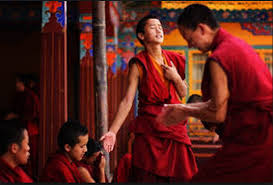
The College Kalachakra Exhibitory Debate
The college exhibitory debates took place during the eleventh month. There were two, an exten-sive and a brief debate.
Debating or the Art of listening to another's opinion on a certain subject while defending your own opinion on the same with certain ritualistic hand gestures was a part of the Tibetan Bodh-Dharma.
At some point before his exhibitory debate the geshe visited his Lama Shung-leg-pa (Hostel study supervisor) to ask him to recommend a subject to comment on at his exhibitory debate. On the crucial day the candidate invited the Lama Shung-leg-pa and all the other geshe candidates to his room. The Lama Shung-leg-pa took his place on a throne and the candidate prostrated before him.
The geshes were awarded their degrees on the twenty-fourth of the first month, at the end of the Great Prayer Festival. If the Dalai Lama was in Lhasa, he presided over the event which took place in the upper storey of the Jokhang.
If the Dalai Lama was not in Lhasa for the Great Prayer Festival, the conferrment of the Geshe degree took place in the Potala.
The geshe degree was formally established at the time of the fifth Dalai Lama in the seven-teenth century, but by the twentieth century, like other long standing institutions its conferrment had began to be regarded as a merely customary event.
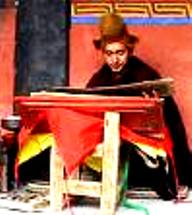
More on Kalachakra Go to Dalai Lama Abode..!
